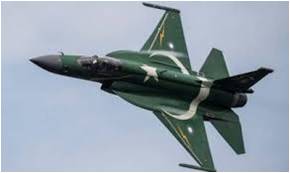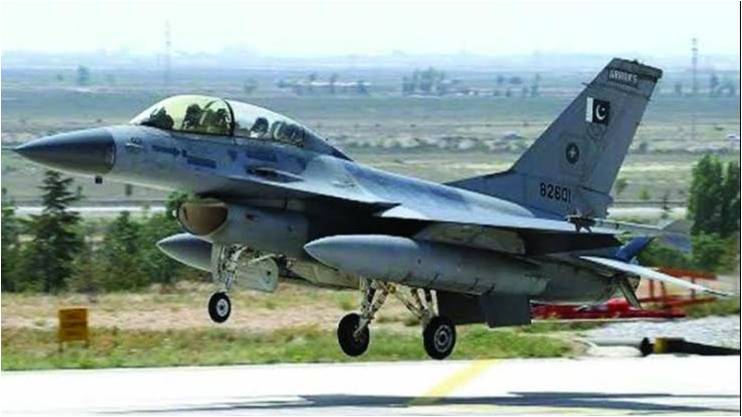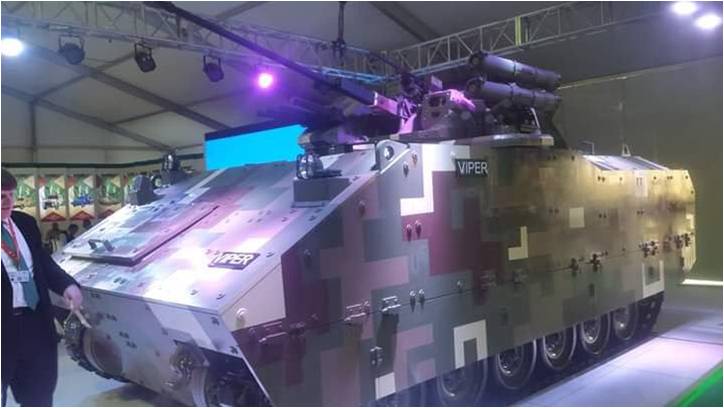Despite all odds…
Despite all the economic woes and downturns, despite spiralling debt trap, and sky-rocketing costs of imports in the face of sharp currency de-valuation, not to mention the IMF imposed economic re-structuring and the recent narrow escape (4 months lifeline given in Oct 2019) from blacklisting by the Financial Action Task Force (FATF), Pakistan Ministry of Defence (MoD) Year Book 2017-18 released in Sept 2019 talks of sustaining the pace of ongoing military development, replacement of foreign equipment, as well as maintaining the momentum of acquisition programmes, currently in progress1.
In particular, the Year book lays priority on the development of two aspects of conventional force capability building, namely, air power and mechanised forces.
Building on the base of known capabilities of Pakistani air power, this article flags what are the new developments taking place in the air and mechanised domain and how much of it could be for the real given the current state of things for Pakistan.
Known Capabilities of Pakistani Air Power
Pakistan Air Force (PAF) has an inventory of some 450 combat aircrafts organised into 20 front-line squadrons. It operates four main types of combat aircrafts, namely, the French Mirage V attack aircrafts (90), Mirage-III interceptors (90), the Chinese J-7 fighters (39) and JF-17 multirole aircrafts (86), and the US F-16 multirole strike aircrafts (76). It is reported that by 2025, PAF will only operate two multirole aircrafts namely F-16 and JF-172.
Over a period of time, the old and obsolete aircrafts (A-5, F-6, Super F-7, FT-7P,) have been phased out. The F-16s have undergone major upgrades to include NATO compatible Link-16 communications, GPS/INS flying, weapon upgrades to include high speed Anti-Radiation Missiles (ARMs), Precision Guided Munitions (PGMs) and more.
Regarding attack helicopters (AHs), the PAF has a fleet of AH-1F Huey Cobras (2 squadrons, 32 helicopters) and the Chinese K-8 (1 squadron, 28 helicopters). AH-1Fs have seen upgrades involving Forward Looking Infra Red (FLIR) night sights and TOW missiles. Besides AHs, PAF operates a small fleet of Unmanned Aerial Systems (UAS) to include ASN- 105 & 106 from China, Snipe and Streak from UK and Luna from Germany. In Sep 2015, Pakistan became the ninth nation in the world to develop and use an armed UAS named Burraq. It is armed with Burq, an Air-to-Surface Missile (ASM) with pin -point precision.
Under the Armed Forces Development Programme (AFFDP 2006-2019), PAF, besides procuring some modern combat aircraft from US and China, has also acquired several cutting edge systems. These include PGMs for J-17 aircraft (LS-6 and LS-6P and SD-10A Beyond Visual Range Missiles). Other known PGMs and ASMs with PAF are ARMs, laser guided bombs (LGBs), Maverick missile and AS-30 ASM useable with Mirages (III & V) and F 16 aircrafts. As regards cruise missile, Nasr (HATF-IX) is a solid fuelled tactical ballistic missile developed as short range (60 km) high accuracy low yield battle field deterrent.
On 19 Sep 2017, PAF announced that it will acquire three new Saab 2000 Erieye Airborne Early Warning and Control (AEW&C) aircrafts. This will join the three existing Erieye and four Y8-600 based ZDK03 AEW&Cs, taking a total of such aircraft to 10 by the end of the decade3. This will provide a tangible enhancement in the airborne surveillance and targeting capability of PAF.
It has also been reported that Pakistan is in talks with China to acquire 30-40 JF-31 stealth fighters. This will add a totally new qualitative dimension to its strike capability.
The Reported Revamp
Continuing with the modernisation trail set forth under the Armed Forces Development Programme 2006-2019, Pakistan is paying attention to further revamp the punch of its JF-17 aircraft as regards its weaponry, night flying capability and electronic warfare package. It will be recalled that JF-17 along with F-16 are the two platforms identified for the long term.
As per MoD report, JF-17 is undergoing two improvements. Firstly, air-to-air refuelling (AAR) capability, and secondly, acquisition of Chinese M-400 AKG supersonic anti-ship missile. This missile will replace the earlier sub-sonic one bringing in a significant improvement in the anti -ship capability of the aircraft. AAR capability will increase the combat radius of the aircraft significantly. Another point worthy of note is the planned enhancement of the numbers of JF 17 to be produced per year. This number is planned to go up from 16 to 24 per year.

Pak JF 17 – poised for a major upgrade
Towards improvement in avionics and the surveillance and the tracking capability of the aircraft, there are plans to retrofit the previous versions of the aircraft with the Active Electronically Scanned Array (AESA) Radars, which is the cutting edge and niche equipment in its class today.
In order to minimise the vulnerability of one’s aerial threat vehicles to the adversary’s air and ground based defences, the trend today is to develop the capability of standoff bombing, where aircrafts can stand-off hundreds of kilometres and can direct PGMs to their intended targets without exposing themselves to adversary’s air defences. Advanced stand-off weaponry like the YBS-500 Chinese air-to-surface missile, REK mark 82, 83, 84 bombs and the H-4 stand-off weapon is being acquired. H-4 is a PGM which is a precision guided glide bomb manufactured by Pakistan. It has a stand-off range of 120 km. The bomb seeks the target through an on-board infrared homing seeker4,5.

An H 4 Bomb on board a Pakistani F 16
The MoD report also mentions the development of a weapon named ‘Al-Rasub’6 (the name of one of the nine swords of Prophet Muhammad). Further details about the weapon are not known.
In the field of combatised Unmanned Aerial Vehicles (UAV) as well, there has been a forward movement. Firstly the indigenous Burraq is maturing ever since its first successful strike in Sep 2015 on a terrorist compound in the Shawal Valley where it was reported that three high profile terrorists were killed7. Burraq has a range of 1000 km, its maximum speed is 215 km/h and it has a service ceiling is 7500 meters. It carries two Burq air-to-surface laser guided missiles8. Burq, which means lightening in urdu, is single-stage missile capable of destroying both stationery, as well as, moving targets9. It has been reported that Burraq has been used to conduct several strikes on terrorist hideouts in the Tirah Valley located in the Khyber Pakhtunkhwa province as a part of Operation Khyber. 10 Burraq has placed in the hands of Pakistan, an effective combatised UAS.

Burraq Combat UAV carrying Burq missile
The second forward movement relates to the Chinese Wing Loong-II combat UAS. There is a Chinese offer to sell 48 numbers of its high-end reconnaissance, strike and multi-role Wing Loong-II Unmanned Combat Aerial Vehicles (UCAV) to Pakistan. The cost of the deal has not been revealed.11 This is not a straight 'sell' deal, in that, the agreement between the State owned Aviation Industry Corporation of China (AVIC) and Pakistan Aeronautical Complex (PAC) is for co-production of 48 Wing Loong-II UCAVs, which by implication, is likely to involve Transfer of Technology (ToT). 12
Wing Loong-II is a Medium Altitude Long Endurance (MALE) UAS developed by the Chengdu Aircraft Industry Group. It has a range of 4000 km, an endurance of 20 hours, a service ceiling of 5000 meters and a maximum speed of 370 km/h. This UAS is an improved version of its predecessor Wing Loong-I. The current version has an optimised aerodynamic design, improved airframe and upgraded airborne systems which feature better capability in terms of flight, payload and information capacity. It is equipped with satellite communication (SATCOM) system. Its electro-optical payload pad fitted under the forward section of the fuselage is integrated with daylight and infrared cameras and sensors to collect surveillance and targeting data in both day and low-light/night conditions13.
The MoD report also talks about the developments in Project Azm, the Fifth Generation Fighter aircraft (FGFA). The report states that the first ‘conceptual design phase’ cycle for Project Azm stands completed. The first configuration will reportedly go through three more cycles within the conceptual design using higher fidelity analysis tools and codes.

Azm – Still very much on paper
Azm in Urdu means conviction, determination and fortitude. It is a Project by the Pakistan Aeronautical Complex (PAC). A new entity under the PAC called the Aviation Research Indigenisation and Development (AvRID) Unit has been established to lead the FGFA Programme. There were unconfirmed reports of basing Azm on the Chinese J-20 or J-31 airframe and technology. Also, there were reports of Pakistan taking help from Turkey in a joint venture effort. Be that as it may, it is assessed that Azm is still very much on paper at this point of time14.
One another combat force that has shown continued activity is the Surface-to-Surface Missiles (SSMs), the latest launch being of Ghaznavi on 29 Aug 2019. Ghaznavi is capable of delivering multiple warheads (both conventional and nuclear) upto 290 km.
Some other Noteables in the Pakistan MoD Report
Besides the activities for the improvement of the air missile capability, the MoD report also gives an indication of the indigenous efforts to bolster the armoured fighting capabilities of the ground forces. These include the indigenous manufacture of the auxiliary power units, as well as, the assembly of engines and indigenous re-building for the Main Battle Tanks (MBTS) Al Zarrar, T-80 UD and Armoured Personnel Carriers (APC) M-113. There is also a mention of the development and trials of Fin Stabilised Discarding Sabot Round with Tracer, a round with a deep penetration power to defeat the adversary’s tanks and mechanised vehicles. Efforts are also on to improve the night fighting capabilities of MBTs through indigenous development of night sights.

Al Zarrar Main Battle Tank
The upgrade of the 1985 vintage Chinese MBT the T-85IIAP over a three year period from 2019-2022 has also been covered in the MoD Report. In addition, the 1958 vintage Chinese T-59 tanks are being upgraded to Al Zarrar. Al Zarrar is named after the Muslim warrior Zarrar bin Al Azwar. Upgradation of Al-Khalid tanks from version I to version II is also reported.
On the APC front , besides the mainframe M-113, the indigenous armoured fighting vehicle manufacturer Heavy Industries Taxila (HIT) has developed Viper ICV based on US M-113 chassis but featuring the EVPU Slovakian Turra-30 unmanned turret (30 mm cannon + 2 anti-tank missiles), a tangible improvement on the firepower of M-113 that only had M2 Browning Machine Gun.

Viper ICVs by Heavy Industries Taxila
Towards building its anti-tank capability, Pakistan has reportedly purchased the Russian Kornet-E laser beam-riding anti-tank guided missiles. For understandable reasons this purchase has not been reported ex-Russia but through an alternate source.
Some Observations
Some obsevations on the Pakistan MoD report are Enumerated:
The dismal state of Pakistan’s economy is no secret. Figures available upon the presentation of the annual budget 2019-2020 indicate a downward growth rate registering a steep fall of almost 50% from 6.2 to 3.2 ( now southbound to about 2.9 as per the IMF Report), the rupee has lost a fifth of its value ( 156.17 to a dollar on 26 Oct 2019). According to the Bloomberg report published in Oct 2019 the Government’s fiscal deficit is already 8.9 % of the GDP, highest in three decades. Drowning in international debt, the country has borrowed a total of $85 billion from various countries and has recently reached out to the International Monitory Fund (IMF) for the record 23rd time for a $6 billion bailout package. 15
While all the above stands on one side, on the other stand some other facts:-
- Even while presenting the austerity-driven budget for the fiscal 2019-20 in Jun 2019, the Government announced that its defence budget will remain undiminished at Rs 1150 billion as compared to fiscal 2018-1916
- It will require a separate article to record the host of irresponsible and reckless statements continuously being made by the Pakistani Prime Minister and his Ministers carrying multiple threats of imminent war, possibility of the use of nuclear weapons and more. The latest being his call for of ‘open jihad’ by ‘standing with the Kashmiri people’ and asking people to head towards the Line of Control ( LoC) 17.
- Pakistani establishment probably realises that while the nukes, especially the tactical nuclear weapons do have their nuisance and blackmail value under whose cover nasty acts of proxy war could be conducted, as the bottom line, the conventional war-fighting capability needs to be maintained above a perceived threshold of security needs. The air power and the mechanised power are two very essential pillars to be further strengthened.
.
The MoD Report is of the year gone by (2017-18), represents the actions completed. How much of it is actually completed is anybody’s guess. Notwithstanding the above, there is no denying the fact that there is a definite forward movement by the Pakistani establishment in its efforts to build the conventional war-fighting capability. A point to be taken note of by the stakeholders on our side
End Notes
- “Government Report reveals Pakistan’s progress on military acquisition amid financial woes,” at www.fdefensenrews.in.accessed on 21 Oct 2019.
- Pakistan Air Force Sqadrons at https://wwwGlobalsecurity.org. Accessed on 21 Oct 2019,
- Pakistan will acquire three new Saab Erieye AEWC&S at https://www. quwa.org>2017/05/21 accessed on 21 Oct 2019.
- “YBS 500” at www.en.wikipedia.org..Accessed on 21 Oct 2019.
- ‘H4 SOW” at en.wikipedia.org. Accessed on 21 Oct 2019.
- 1 ibid.
- "Pakistan surprises many with first use of armed drone," at www.defencenews.com. Accessed 22 Oct 2019.
- "NESCOM Burraq Unmanned Combat aerial Vehicle," at www.militaryfactory.com. Accessed 22 Oct 2019.
- "Pakistan to show missile muscle," at www.defwnce .pk. accessed 22 Oct 2019.
- 14 ibid.
- "China to sell 48 high-end military drones to Pakistan," at www.economivtimes.indiatimes.com. Accessed on 22 Oct 2019.
- "China, Pakistan to co-produce 48 strike capable Wing Loong II drones, "at www.thediplomat.com. Accessed 22 Oct 2019.
- "Wing Loong II MALE..." at www.armyrecognition.com. Accessed 22 Oct 2019.
- “What is Project Azm by Pakistan air Force”, at www.quora.com. Accessed on 22 Oct 2019.
- “Explained: what ails Pakistan’s? Is it drowning in debt/” at www.indianexpress.com. Accessed on 26 Oct 2019.
- “No change in Pakistan’s defence budget amid Govt austerity drive,” at www.businesstoday.in. Accessed on 26 Oct 2019.
- “Imran Khan’s open jihad call not normal behaviour..,” at www.indiatoday.in. Accessed on 26 Oct 2019.
(The paper is the author’s individual scholastic articulation. The author certifies that the article/paper is original in content, unpublished and it has not been submitted for publication/web upload elsewhere, and that the facts and figures quoted are duly referenced, as needed, and are believed to be correct). (The paper does not necessarily represent the organisational stance... More >>
Image Source: https://trofire.com/wp-content/uploads/2018/01/2018-01-21-Military-Funding.jpg










Post new comment